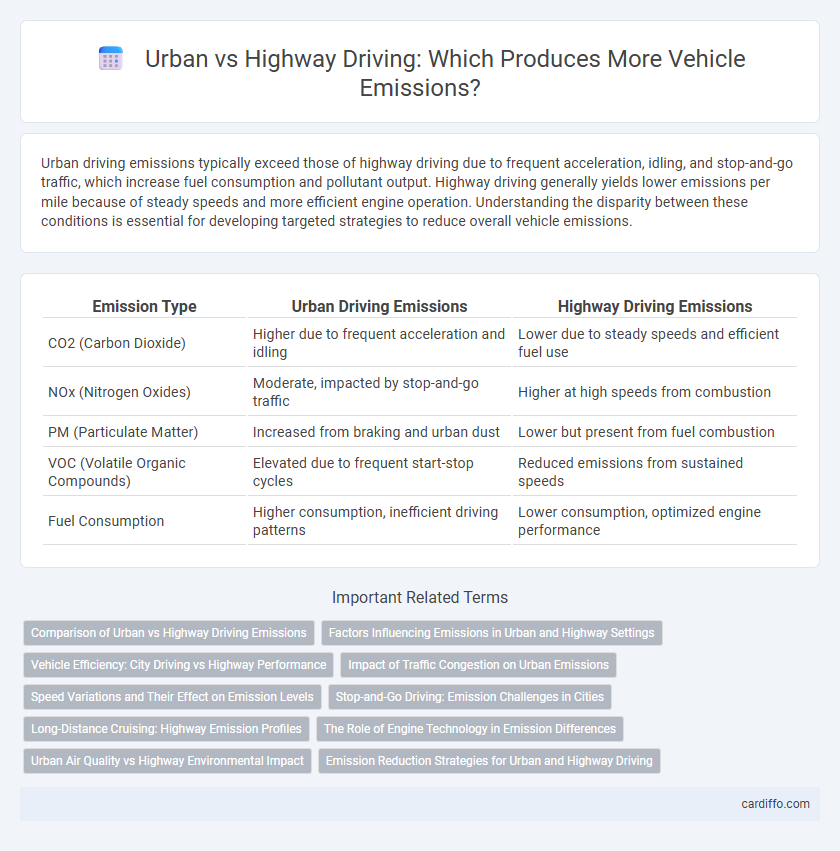Urban driving emissions typically exceed those of highway driving due to frequent acceleration, idling, and stop-and-go traffic, which increase fuel consumption and pollutant output. Highway driving generally yields lower emissions per mile because of steady speeds and more efficient engine operation. Understanding the disparity between these conditions is essential for developing targeted strategies to reduce overall vehicle emissions.
Table of Comparison
| Emission Type | Urban Driving Emissions | Highway Driving Emissions |
|---|---|---|
| CO2 (Carbon Dioxide) | Higher due to frequent acceleration and idling | Lower due to steady speeds and efficient fuel use |
| NOx (Nitrogen Oxides) | Moderate, impacted by stop-and-go traffic | Higher at high speeds from combustion |
| PM (Particulate Matter) | Increased from braking and urban dust | Lower but present from fuel combustion |
| VOC (Volatile Organic Compounds) | Elevated due to frequent start-stop cycles | Reduced emissions from sustained speeds |
| Fuel Consumption | Higher consumption, inefficient driving patterns | Lower consumption, optimized engine performance |
Comparison of Urban vs Highway Driving Emissions
Urban driving emissions are significantly higher per mile due to frequent acceleration, deceleration, and idling, causing increased carbon monoxide, nitrogen oxides, and particulate matter levels. Highway driving emissions are generally lower per mile because of steady speeds and efficient fuel consumption, resulting in reduced pollutants and greenhouse gas output. Analyzing emission factors reveals urban environments contribute disproportionately to air pollution and necessitate targeted regulatory measures to reduce vehicle-related emissions.
Factors Influencing Emissions in Urban and Highway Settings
Urban driving emissions tend to be higher due to frequent idling, stop-and-go traffic, and lower speeds, which increase fuel consumption and pollutant output. Highway driving emissions typically occur at steadier speeds, allowing for more efficient fuel use, but can generate higher emissions during rapid acceleration or heavy loads. Factors influencing emissions in both settings include vehicle type, engine efficiency, traffic density, and air conditioning use.
Vehicle Efficiency: City Driving vs Highway Performance
Urban driving emissions are typically higher due to frequent stops, idling, and lower average speeds, which reduce vehicle efficiency. Highway driving allows vehicles to maintain steady speeds, optimizing fuel combustion and lowering emissions per mile. Hybrid and electric vehicles show improved efficiency in city driving by recapturing energy during braking, further reducing urban emissions compared to conventional engines.
Impact of Traffic Congestion on Urban Emissions
Traffic congestion significantly increases urban driving emissions by causing frequent acceleration and idling, which leads to higher fuel consumption and elevated levels of pollutants such as nitrogen oxides (NOx) and particulate matter (PM). Studies show that vehicles in congested urban areas emit up to 30% more greenhouse gases compared to free-flowing highway traffic. This heightened emission intensity contributes disproportionately to urban air quality deterioration and public health risks.
Speed Variations and Their Effect on Emission Levels
Speed variations in urban driving lead to frequent acceleration and deceleration, significantly increasing emissions of nitrogen oxides (NOx) and particulate matter (PM) compared to more consistent speeds on highways. Urban stop-and-go traffic causes engines to operate less efficiently, raising carbon monoxide (CO) and volatile organic compound (VOC) emissions. Highway driving's steady speeds result in lower fuel consumption and reduced greenhouse gas emissions such as carbon dioxide (CO2).
Stop-and-Go Driving: Emission Challenges in Cities
Stop-and-go driving in urban areas significantly increases emissions due to frequent acceleration and idling, which causes higher fuel consumption and elevated levels of nitrogen oxides (NOx) and particulate matter (PM). Studies show that urban driving can produce up to 30% more carbon dioxide (CO2) emissions compared to steady highway driving. Traffic congestion and traffic light cycles exacerbate these emission challenges, making cities hotspots for air pollution.
Long-Distance Cruising: Highway Emission Profiles
Highway driving typically produces lower emissions per mile compared to urban driving due to steady speeds and fewer stops, resulting in improved fuel efficiency and reduced carbon monoxide (CO) and nitrogen oxides (NOx) emissions. Long-distance cruising maintains a constant engine load, minimizing the combustion inefficiencies common in stop-and-go traffic and significantly decreasing particulate matter (PM) emissions. This emission profile highlights the environmental benefits of highway travel, especially over extended distances where faster speeds and continuous motion optimize combustion efficiency.
The Role of Engine Technology in Emission Differences
Advanced engine technology significantly reduces urban driving emissions by optimizing fuel combustion and enhancing stop-and-go efficiency, which addresses frequent acceleration and idling. Modern direct injection systems and variable valve timing improve highway driving emissions by enabling consistent fuel delivery and maximizing engine performance at high speeds. Emission control technologies like catalytic converters and particulate filters further minimize pollutants in both urban and highway environments, highlighting the critical role of engine innovations in emission reduction.
Urban Air Quality vs Highway Environmental Impact
Urban driving emissions primarily consist of higher concentrations of nitrogen oxides (NOx) and particulate matter (PM) due to frequent acceleration, deceleration, and idling, significantly degrading urban air quality and contributing to smog formation. Highway driving emissions typically produce more carbon dioxide (CO2) because of sustained high speeds and engine load, leading to greater greenhouse gas accumulation and long-term environmental impact on climate change. The difference in pollutant types highlights the need for targeted emission reduction strategies to improve both urban air quality and mitigate highway-induced environmental damage.
Emission Reduction Strategies for Urban and Highway Driving
Urban driving emissions primarily result from frequent acceleration and idling, leading to higher levels of nitrogen oxides (NOx) and particulate matter (PM), while highway driving emissions are dominated by continuous fuel consumption producing more carbon dioxide (CO2). Emission reduction strategies for urban driving focus on optimizing stop-and-go traffic through technologies like start-stop systems, electric vehicles (EVs), and enhanced public transit options. Highway driving benefits from aerodynamic vehicle designs, high-efficiency engines, and the adoption of hybrid or electric powertrains to minimize CO2 emissions during sustained speeds.
Urban Driving Emissions vs Highway Driving Emissions Infographic

 cardiffo.com
cardiffo.com